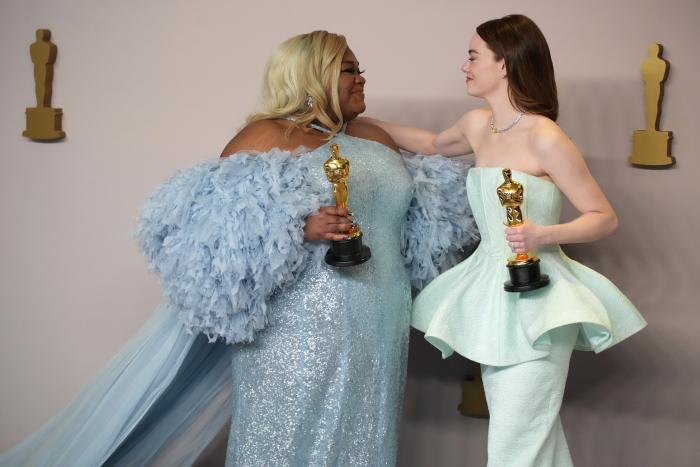

Mattel Asked Little Girls And Feminists For Advice On DC Super Hero Girls
By Kristy Puchko | DC Movies | October 13, 2015 |
By Kristy Puchko | DC Movies | October 13, 2015 |
There’s been a growing demand for superhero toys for girls. And while Marvel/Disney’s merchandizing has been all retconning their biggest heroine right out of her biggest scenes, DC/Mattel have been working to do right by girls and women. At New York Comic Con, DC SuperHero Girls had a big booth that included a photo-op backdrop and a display of the dolls to be released in 2016. And though I spent the whole damn weekend there, I never got close enough to see the dolls because that display was always rows deep with kids and adults clamoring to see the new girl-friendly incarnations of Wonder Woman, Supergirl, Batgirl and Harley Quinn. But how do you make girls toys that draw this kind of attention? Talk to girls.
Bloomberg Business went to Mattel’s headquarters to uncover the development of DC SuperHero Girls, a line intended for girls ages 6-12, which will include 12-inch dolls, 6-inch action figures, and gadgets like a Batgirl utility belt and a Wonder Woman shield that shoots plastic discs 20 feet. With Barbie’s sales on the decline, Mattel needed to consider what girls today really want. When research showed that girls purchase 9% of action figures despite the fact that’s a market that acts like girls don’t exist and women are meant to be ogled, Mattel had the idea to make superhero dolls that would appeal to girls. And to understand what that means, they flat-out asked little girls what they wanted.
When the initial models for these dolls were presented to their target audience, the girls complained they were “more pretty than superhero,” clocking Poison Ivy for a scarf that’d be impractical when she needed to fight. And Wonder Woman’s super skinny look earned scowls that pushed the design team—led Christine Kim—to use the bodies of gymnasts, dancers, and basketball players as muses for their doll’s muscles. Because these Super Hero Girls are meant to be in high school, Mattel made them toned but “not fully mature,” but Kim’s proud that “they still look like they can save the day instead of being saved.”
After the girls had their say and revisions were made, Mattel brought in “a dozen of its biggest critics: a collection of feminists, bloggers, and academics.” As these dolls are more muscular than many of their fashion doll sisters, and not sexualized as their action figure cousins, and showed a clear effort to include some diversity (with Katana and Bumblebee) they won praise from the panel. Of course, these dolls are already drawing some criticism for a lack of body diversity. But this is a major step, and the line’s success could mean more merchandizing companies will follow Mattel’s lead.
And of course, no doll marketing campaign would be complete without a cartoon series to sell the characters. (Sorry, Dustin.)
Kristy Puchko would have adored these dolls as a kid, may now.
← What's the Big Difference Between Netflix's Jessica Jones and Other Marvel Series? | How The Sony Hack Made Jennifer Lawrence Recognize Hollywood Sexism →
More Like This
We Are Finally Seeing Some Actual Marketing For 'Aquaman and the Lost Kingdom'
A Look Back At 'Batman' and Why Michael Keaton Is Still Everyone's Favorite
James Gunn Confirms More Casting News For 'Superman: Legacy'
David Corenswet And Rachel Brosnahan Are The New Superman and Lois Lane Of The DCU
Everything You Need To Know About 'Man of Steel' On Its 10th Anniversary

What’s Old Is New Again: Old Hollywood Glamour Glitters at the 2024 Oscars
Al Pacino Presents Best Picture Oscar, Confuses Everyone
The Dangerous Lie Of 'TradWives'
A Legendary Horror Franchise Is Headed To Television
'The Mandalorian' Season 4 Is Probably Not Happening
Halle Bailey On Why She Chose To Keep Her Pregnancy Private
More Like This
We Are Finally Seeing Some Actual Marketing For 'Aquaman and the Lost Kingdom'
A Look Back At 'Batman' and Why Michael Keaton Is Still Everyone's Favorite
James Gunn Confirms More Casting News For 'Superman: Legacy'
David Corenswet And Rachel Brosnahan Are The New Superman and Lois Lane Of The DCU
Everything You Need To Know About 'Man of Steel' On Its 10th Anniversary
Reviews